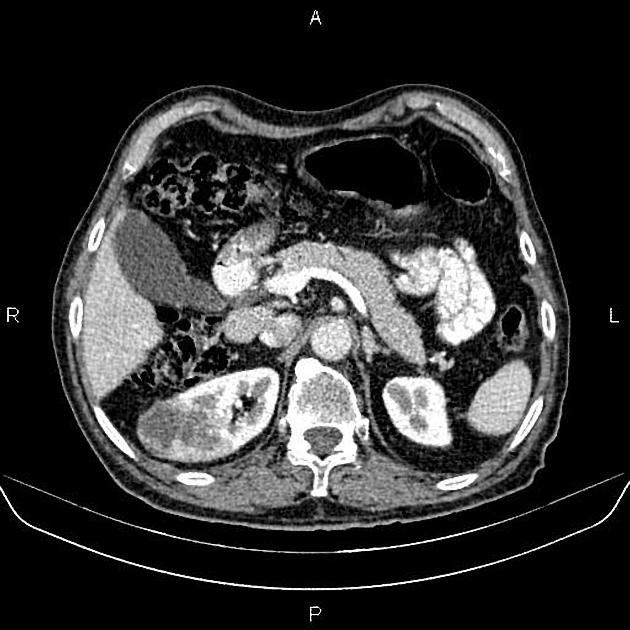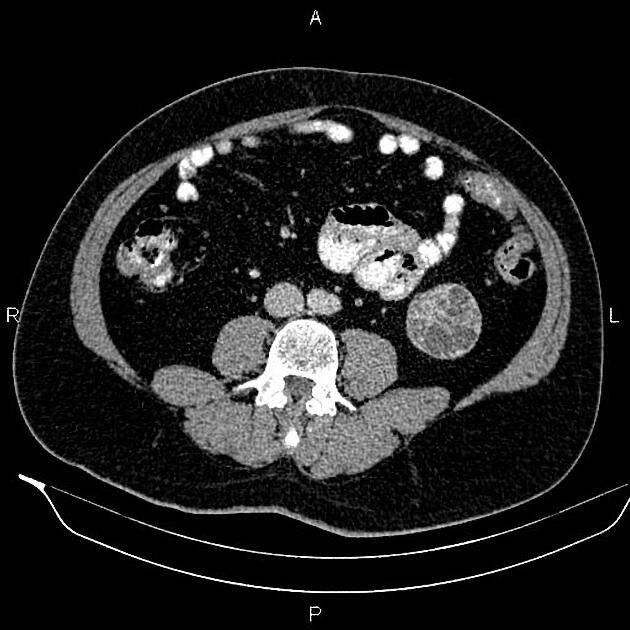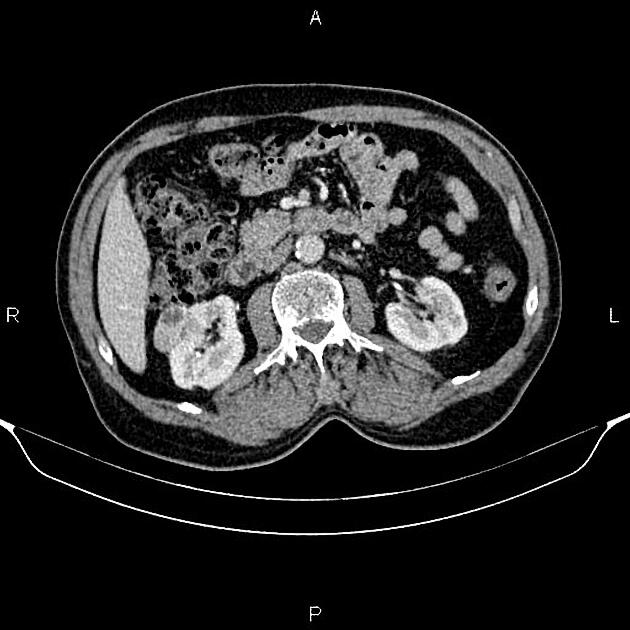The Bosniak classification of cystic renal masses (version 2019), or usually simply Bosniak classification v2019, is an update of the Bosniak criteria published in 2005.
On this page:
Usage
The Bosniak classification version referred to international guidelines is variable, with the 2022 European and Canadian guidelines referencing v2019 9,10 and the 2021 American guidelines referencing v2005 11,12.
A 2023 meta-analysis reports that using v2019 would have resulted in fewer benign cyst resections (by ~2%) and more cysts categorized as class III and class IV; however, compared to v2005, the interobserver reliability is significantly less 13.
Bosniak v2019 employs the term "class", replacing the v2005 use of "category" for the different groups but retaining Roman numerals 1.
Classification
The new version has separate CT and MRI criteria:
CT
Class I
well-defined thin (≤2 mm) smooth wall
homogeneous simple fluid (-9 to 20 HU)
no septa or calcification
the wall may enhance after the administration of contrast
Class II
-
six types, all with thin (≤2 mm) smooth walls
-
cystic masses with thin (≤2 mm) and few (1-3) septa
septa and wall may enhance
may have calcifications of any type (although if the calcification is thick and nodular, consider MRI before assigning a class)
homogeneous hyperattenuating (≥70 HU) masses on non-contrast CT
-
homogeneous non-enhancing masses >20 HU at renal mass protocol CT
may have calcifications of any type (although if the calcification is thick and nodular, consider MRI before assigning a class)
homogeneous masses (-9 to 20 HU at non-contrast CT)
homogeneous masses (21 to 30 HU at portal venous phase CT)
homogeneous low attenuation masses that are too small to characterize
-
Class IIF
smooth minimally thickened (3 mm) enhancing wall
smooth minimal thickening (3 mm) of one or more enhancing septa
many (≥4) smooth thin (≤2 mm) enhancing septa
Class III
-
one or more walls or septa that are
enhancing thick (≥4 mm width)
enhancing irregular (displaying ≤3 mm obtusely margined convex protrusion[s])
Class IV
-
one or more enhancing nodule(s)
≥4 mm convex protrusion with obtuse margins
a convex protrusion of any size that has acute margins
MRI
Class I
well-defined thin (≤2 mm) smooth wall
homogeneous simple fluid (signal intensity similar to CSF)
no septa or calcification
the wall may enhance after the administration of contrast
Class II
-
three types, all with thin (≤2 mm) smooth walls
-
cystic masses with
thin (≤2 mm) and few (1-3) enhancing septa
any non-enhancing septa
calcification of any type
homogeneous masses markedly hyperintense at T2W (similar to CSF) at non-contrast MRI
homogeneous masses markedly hyperintense at T1W (approximately 2.5 times that of normal parenchymal signal intensity) at non-contrast MRI
-
Class IIF
-
two types:
-
cystic masses with
smooth minimally thickened (3 mm) enhancing wall
smooth minimal thickening (3 mm) of one or more enhancing septa
many (≥4) smooth thin (≤2 mm) enhancing septa
cystic masses that are heterogeneously hyperintense at unenhanced fat-saturated T1W imaging
-
Class III
-
one or more walls or septa that are
enhancing thick (≥4 mm width)
enhancing irregular (displaying ≤3 mm obtusely margined convex protrusion[s])
Class IV
-
one or more enhancing nodule(s)
≥4 mm convex protrusion with obtuse margins
a convex protrusion of any size that has acute margins
Follow up
Class I
"Benign simple renal cyst requiring no follow up"
Class II
"Benign Bosniak II renal cyst requiring no follow up"
"Likely benign Bosniak II renal mass requiring no follow up"
Class IIF
"Bosniak IIF cystic renal mass. The large majority of Bosniak IIF masses are benign. When malignant, nearly all are indolent. Generally, Bosniak IIF masses are followed at imaging at 6 months and 12 months, then annually for a total of 5 years to assess for morphologic change"
Class III
"Bosniak III cystic renal mass. Bosniak III masses have an intermediate probability of being malignant. If not already obtained, consider urology consultation"
Class IV
"Bosniak IV cystic renal mass. The large majority (up to 90%) of Bosniak IV masses are malignant. If not already obtained, consider urology consultation"
Practical points
the increased specificity in terms of thickness of walls and septa, and number of septa, is intended to increase inter-reader agreement
the differentiation between "irregular thickening" (Bosniak III) and "nodule" (Bosniak IV) is intended to reduce the percentage of Bosniak IV masses that are benign
this classification scheme is intended for a general patient and not for those with a renal cell carcinoma syndrome
what constitutes "measurable enhancement" has not been formally defined in the 2019 version; in 2005 Bosniak stated that an increase of 20 HU or more at contrast-enhanced CT was likely enhancement, whilst 10-20 HU was indeterminate 7; another group suggested an increase of 15% signal intensity or more at contrast-enhanced MRI 8
according to the Bosniak classification 2019, if the enhancing solid component volume of a renal cystic lesion is more than 25% of all mass volume, the Bosniak classification should not be used and the mass should be instead categorized as a solid renal mass with cystic/necrotic changes; because a solid renal cell carcinoma with cystic/necrotic changes has a poor prognosis compared to the renal cell carcinoma that is arising from a Bosniak class IV cystic renal mass 1
renal cyst-like lesions with an infectious, inflammatory and vascular etiology should not be classified by Bosniak system 1
History and etymology
The proposed new version of Bosniak classification of cystic renal masses is the first major revision since the death of the American radiologist Morton Bosniak (1929-2016), who died three years earlier. Bosniak published the first iteration of his classification system in 1986 6.
External links
If any of these links are broken or for other problems and questions, please contact editors@radiopaedia.org.






















 Unable to process the form. Check for errors and try again.
Unable to process the form. Check for errors and try again.